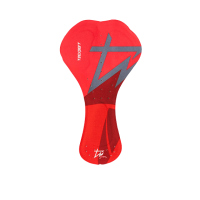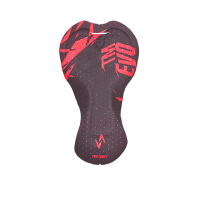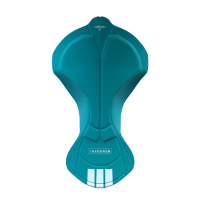01 Jun Cycling pad: how to fit it correctly to prevent redness
How it is and what is used for
A cycling pad is a padding made by combining technical fabrics and foams sewn into the inside of cycling shorts. Designed to protect the intimate parts of cyclists, it also supports the bone structure and reinforces the cycling shorts.
Practical and useful for both men and women, the pad is an important item in shorts produced also in several models and configurations.

Cycling pads are designed by specialized companies, drawing a distinction between women’s and men’s chamois. Those for women are rounded in shape and it reflects the conformation of the pelvis of women, with greater distance between the ischial bones.
In addition, they have a different structure and configuration of the foams, designed to support the women’s type of support and to prevent excessive pressure in the pubic area.
On the other hand, men’s chamois are designed with a central channel that ensures a correct blood flow in the intimate area. You should never wear pads belonging to the opposing sex, as it could lead to pain in the perineal area or other serious problems.
How to understand if the cycling pad is correctly placed
In order to avoid irritation and inflammation of the rider, the fitting of the pad in the cycling shorts is very important.
The following tips will help you to check if the shorts you are wearing have the pad fitted correctly:
- Establishing the ideal saddle height on the bike
- Wearing the shorts
- Getting on the bike and position yourself with your feet on the pedals and your hands on the handlebars.
- Getting on the bike and place your feet on the pedals and your hands on the handlebars.
- Standing behind the rider in the saddle and check how many centimeters of seat pad you see: if the answer is 2 to 3 cm, then the pad is properly positioned.
- Paying attention to the sensitivity of bones and intimate parts once seated.
How to find the correct cycling pad position
Over the years we have helped many brands and manufacturers to ensure that their shorts fit perfectly, so we have explained step by step how to find the correct position of our cycling pads in our shorts.
Here is our guide to never mistake the position of the pad again:
- Getting a roller and balancing the bike;
- Fitting the cycling trousers without the pad;
- Placing the chamois on the saddle and having the cyclist sit on it. It is important that at this stage the cyclist has a natural position with feet in the pedals and hands in the handlebars.
- Adjusting the position and finding the right support place to ensure a perfect outcome, i.e. the ischial bones must match the inserts of the seat pad created to protect them.
- Once found the perfect spot, make the pad fit on the outside of the cycling shorts and make a mark.
- Measuring from the marked point to the end of the fabric panel of the shorts.This process is very important and it should be carried out with great precision at the front and back.
- When removing the shorts, check the measurements taken previously but on the unworn shorts, the size will decrease because the material is no longer stretched as it is when worn. Then mark the new measurements.
- Marking the last measurements on the shorts.
- Applying the pad to the panel of material with pins.
- Continuing with the sewing of the pad
- After sewing the pad and completing the shorts, it is important to check again that the pad is in the right place for the rider.
This process allows you to fix the pad to the shorts properly, respecting people’s anatomical features.Furthermore, it is essential to repeat this step when changing the model of pad or shorts, as the initial references can never be corrected.
Any wrong positioning can cause redness, pimples or frictions that turn into annoying pains and prevent the cyclist being able to ride further.
The design of the pad by discipline
Each cycling pad is designed on the posture assumed by the cyclist depending on the discipline. For example, the position of a racing bike is different from that of a mountain biker.
As a result, a pad designed for a racing bike is different from one designed for mountain biking. Therefore, for every discipline there is the right pad to wear and you have to choose the right one to protect your intimate parts properly.
TRIATHLON

MOUNTAIN BIKE

ROAD

As a result, a pad designed for a racing bike is different from one designed for mountain biking. Therefore, for every discipline there is the right pad to wear and you have to choose the right one to protect your intimate parts properly.
Read also “how to choose a MTB chamois””
Underwear and pad: a mistake you should never make in life
The anatomical structure of cycling pads is specially designed to be in direct contact with the rider’s naked skin.
Thanks to its special structure, the pad protects the perineal area, a condition that would not be possible with pants, boxer shorts.
Wearing underwear under the seat pad is often the mistake many cyclists make, especially in the amateur world.
What affects the pad’s comfort
Cycling shorts are inevitably exposed to abrasion and once compression and elasticity are reduced, they no further provide protection and comfort.
A good way to make the pad last longer is to remove it as soon as you can after riding and to wash it with mild soap at a low temperature.
There are also, however, very high-quality pads that last longer, but even when they wear out they should be replaced to avoid causing lacerations to the leather.
When buying, you pay attention to the quality of the material: it must have stretchy, bacteriostatic properties, and be quick-drying and quickly absorb sweat.
The foam density also makes a difference in a pad: it should have no differences between the supporting and surrounding parts
In particular, Teosport tests and uses innovative materials and cutting-edge technology to produce new-generation pads that ensure total release in the genital areas and provide optimal ventilation to the less ventilated areas exposed to overheating.
